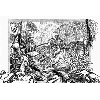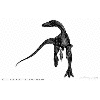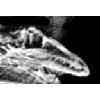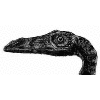CLASSIFICATION
| Coelophysis Cope & Colbert, 1964 [nomen conservandum]TYPE SPECIES: C. bauri (Cope & Colbert, 1964) [nomen conservandum] (originally Coelurus) MISASSIGNED SPECIES: C. holyokensis (Talbot, 1911) (originally Podokesaurus) “hollow form from Holyoke” = Podokesaurus holyokensis C. longicollis (Cope, 1887) (originally Coelurus) == C. posthumus (von Huene, 1908) [nomen dubium] (originally Tanystropheus) == Halticosaurus longotarsus C. rhodesiensis (Raath, 1969) (originally Syntarsus) = Syntarsus rhodesiensis C. willistoni (Cope, 1887) (originally Tanystropheus) == | Animalia Vertebrata Tetrapoda Sauropsida Archosauromorpha Ornithodira Dinosauria Sauropodomorpha |
see also: Genus Index, Classification
MEASUREMENTS
TIME
see also: Ages of the Mesozoic
PLACE
REMAINS
ESSAY
| Coelophysis, a very common little hunter of the Late Triassic, came in two forms, “robust” and “gracile”. These two forms, or “morphs”, probably represent the two genders. There was a recent disagreement over the proper name for Coelophysis. The type specimen (that is, the specimen used to define the genus) was rather fragmentary. Most of our knowledge of Coelophysis comes instead from dozens of very well-preserved specimens found at a site called Ghost Ranch. Some scientists recently argued that the Ghost Ranch dinosaurs might not necessarily be the same as the original Coelophysis specimen. They proposed a new name for the Ghost Ranch dinosaurs – Rioarribasaurus. But by this time the association of the name Coelophysis with the Ghost Ranch material had become heavily entrenched in dinosaur terminology. The ICZN (International Commission on Zoological Nomenclature) voted to redefine the type specimen of Coelophysis as one of the Ghost Ranch specimens. So the name Rioarribasaurus has been officially dropped. The original type material, which may or may not belong to the same kind of animal as the neotype, has been given its own (dubious) genus: Eucoelophysis (“true Coelophysis“). A Coelophysis skull from the Carnegie Museum of Natural History became the first dinosaur fossil to be taken into space on January 22, 1998 when the Endeavor Space Shuttle took off for Mir Space Station. |
IMAGES
Click on thumbnail to see full image.

| A Coelophysis bauri hunts in the Triassic forest (with Dicroidium flora). |


